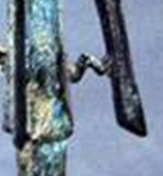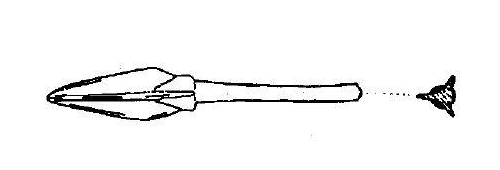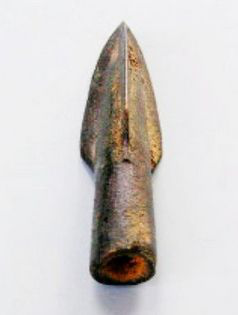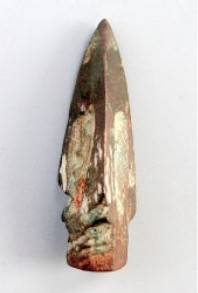Zu or arrowhead, commonly known as Jiantou in Chinese, is the most lethal part at the front side of an arrow. It consists of a sharp point, two opening prongs, a Ji axis and a Ting tang. Because of the special shape of the arrowhead, all its parts have their special names: the sharp point in the front is called Qianfeng; the two sides, Yi; the sharp part on the Yi, Ren; the barb under the Yi, Houfeng; the joint between Houfeng and Ji in the middle, Ben; the joint between the Houfeng of Ji and Ting, Guan; the round shaft at the rear of Guan, Ting.
As one of the earliest cold weapons, bows and arrows had been used by our ancestors for hunting as early as the Paleolithic Age. As recorded in the Book of Changes · Xi Ci, “They bent wood by means of string so as to form bows, and sharpened wood so as to make arrows.” According to it, wooden bows are named Hu, and arrows, Shi. During archaeological excavations, it is rare to find bows and arrow shafts of the Stone Age (bows and shafts were made of bamboo, wood, rattan and other perishable materials. Generally, they could not be preserved till today). However, a large number of arrowheads dating from the Stone Age have been unearthed. Made of stone, bone, clamshell, pottery and other materials, most of them were polished into different shapes. In the late Neolithic Age, some arrowheads were polished into regular and symmetrical shapes, close to metal ones of the later generations.
Followed the first discovery at the Erlitou cultural site, a large number of arrowheads have been unearthed. At the time, arrowheads were small in size, the end of the prong is sweepback-shaped, and the Ting tang is short. There are also some with cone-shaped heads or with broad wings yet without Houfeng part. In the early Shang Dynasty, the arrowheads had been widely used. Some of them had the same shapes as those of Erlitou Culture period, while some had short ridges and solid Ting tangs. In the mid-Spring and Autumn Period, the two prongs of the arrowheads were flared, and openworked and triangular arrowheads appeared. In the Warring States Period, openworked arrowheads had been widely used. And the three-pronged arrowhead dating back to the Warring States Period also reflects this feature. Meanwhile, in ancient times, bags used to contain arrows were generally called Fu, and made of leather or wood.
In the Bronze Age, just like the arrowheads, bows became more elastic after repeated improvement of design. In the Shang Dynasty composite bows made of more than two layers of materials appeared, and they were stronger than primitive self bow with a far longer arrow range. During chariot battles in the Shang and Zhou dynasties, bows and arrows were the main weapon used by the two sides. The unearthed objects indicate that besides the long, short, self and composite bows made of wood and bamboo, some compound bows at a higher level began to be used in the Spring and Autumn and Warring States periods. Starting from the Han Dynasty, to meet the needs of infantry, navy and cavalry, bows were made to be more suitable for fighting, and different types of bows with diversified designs were produced, such as Huben Bow, Jiaoduan Bow, Diaogong Bow, Lugong Bow, and Qianggong Bow.
As a weapon that can kill the enemy from a long distance, bows ranked 1st among weapons and were widely used in ancient times. Children from nobles and generals’ families should learn archery in childhood. As a kind of skill, archery became one of the Six Noble Arts that princes and high-rank officials should grasp. It was regarded not only as a kind of dignified ritual during emperors’ meetings and banquets, but also as a kind of etiquette in folk customs. For example, when a boy was born, his family would hang a bow at the gate to express parents’ wishes for the boy's growing into a strong and courageous man excelling in archery.
The most important factor for archers equipped with bows and arrows is their strength. In ancient times, a first-class bow had a draw weight of about 60kg, and an archer with great strength could draw a bow with a draw weight of about 150kg. The draw weight decides the arrow range, penetration and shooting accuracy. For different targets, the arrow shaft, as well as the size, shape and weight of the arrowhead would be adjusted and vary. During archaeological excavations, we found a ridge-shaped arrowhead with iron head and bronze tail was embedded in a robust hipbone at the ancient site of Changping Battle in Jincheng of Shanxi. Obviously it was shot during the battle in the past, and we can imagine the great strength that was needed to shoot the arrow.
To improve the lethality of bows and arrows as weapons and expand their practical function, ancient people designed small arrowheads in various forms, for example, two-pronged, three-pronged, flat-leafed, willow-leafed, grooved and cone-shaped ones. This one found in the tomb of Huixian County, Henan Province, features one of these forms. In ancient battles, the two troops usually arrayed facing each other in battle formation. Therefore, bows and arrows played a vital role and occupied an important position in the army.
Arrowheads used in battlefields usually featured special design, such as the groove and barbs. The groove would cause a quick loss of the victims’blood and ability to fight. The barbs would increase the victims’ pain and thus undermine their morale. To make the arrows more lethal, ancient people applied arsenic and poison to the arrowhead, and the victims would immediately find it difficult to breathe and feel weak, and die quickly.

Yang Yang: serves at Henan Museum with a bachelor's degree in law, and an academic title of Museologist, dedicating herself to museology and research on history and culture.

Cai Jie: Serves at Henan Museum, with an academic title of Museologist, dedicating to the pre-Qin archaeology and research on history and culture.
In August 1935, local farmers found a bronze Ding when they dug the earth in the area north of Liulige in the southern suburb of the county seat of Huixian. After excavation, two tombs were discovered, and people named them Tomb A and Tomb B respectively. More than 1,000 bronze, jade, stone and pottery articles have been unearthed, and the three-pronged arrowhead was found in the northeast corner of Tomb A.


Fig. 1 Part of the three-throng arrowhead
This three-pronged arrowhead dating back to the Warring States Period features a sharp point, a triangular cross-section, a Houfeng part (rear blade) and three flared prongs. Two thirds of the rear parts of the prongs are openworked, and at the tail there are wave-shaped thin supports connected with the Guan part. Such design helps to balance the air resistance during the flight of the arrowhead so as to maintain its stability. Moreover, the angles formed by the three prongs have the same function as that of the groove on the blade of the double-pronged arrowhead, and they highlight the feature of three-pronged arrowhead, i.e. emphasizing both lethality and penetration.
On the other hand, the bronze arrowhead can only be projected for a longer flight when it is tied to a shaft. The nock at the tip of the shaft is called Kuo in Chinese, and above it there is Yu which occupies one fifth of the shaft and is used to prevent the arrow from shaking during the flight. The arrowhead, the shaft and the Yu forms an arrow in a real sense.
As a kind of commonly-seen weapon in ancient times, bronze arrowheads were important weapons owned by different clans in the Central Plains and surrounding areas as well as other overseas places throughout the Bronze Age.
A bronze three-pronged arrowhead unearthed at the Phase-3 site of Shang Culture at Laoniupo in Xi’an has three wide prongs on the body which contract into a point at the front. Measuring 6.2cm long, it has no Houfeng part, and its Ting tang is cylindrical. It also has the Guan part, and there is a distinctive border between the body and the Ting tang. (Fig. 2)

Fig. 2 The bronze three-pronged arrowhead unearthed from the Phase-3 site of Shang Culture at Laoniupo in Xi’an
A three-pronged arrowhead unearthed from Longxi Hill is housed by Changxing County Museum. With a narrow body, it has three prongs (three blades) on the round ridge (Fig. 3), which are usually placed at equal angles of 120°. The three curved blades contract into a point at the front end. It has no Houfeng part, and a round hollow shaft. The arrowhead measures 4.2cm in overall length and 1.7cm in the length of the hollow shaft.

Fig. 3 The three-pronged arrowhead unearthed from Longxi Hill housed by Changxing County Museum
Those playing an important role in the battle included the three-pronged and the three-edged arrowheads. The three-edged arrowhead features a triangular cross-section, and no flared prongs. The three edges are the blades. The three-pronged arrowhead features three throngs that are usually placed at equal angles (i.e. c. 120°) around the Ji axis and form three blades. The three-edged arrowhead features a triangular cross-section, and no flared prongs. The three edges are the blades, with Ben part under the Ji part.
A three-edged arrowhead (Fig. 4) was unearthed from the tomb of the early Shang Dynasty in Taixi Village of Gaocheng, Hebei Province. It has a triangular cross-section, and a round Ting tang. The lower end is damaged, and the remaining length is 5.8cm.

Fig. 4 The three-edged arrowhead unearthed from Taixi Village of Gaocheng, Hebei Province
The three-edged arrowhead in the collection of Changxing County Museum, which was transferred from Xiaopu Collecting Station, features a body whose bottom part slants forwards in a straight manner and gradually contracts into a point. All three sides on the body sink into grooves. The Ting tang, measuring 0.6cm, is short and thick. The whole arrowhead measures 3.5cm long. (Fig. 4)

Fig. 5 The three-edged arrowhead housed by Changxing County Museum, which was transferred from Xiaopu Collecting Station
As early as the Erligang phase dating from the Shang Dynasty, both three-pronged and three-edged arrowheads appeared. In the Warring States Period, they became one of the widely deployed weapons and also of the major weapons in battles for their great lethality. Most of the arrowheads unearthed from archaeological excavations feature sharp points and blades. In comparison, the annexed prongs are highlighted on the three-pronged arrowheads, and the angles formed by the three prongs help to balance the air resistance during the flight of the arrowhead so as to maintain its stability, improve the long-range aggressivity and penetration into the targets. Therefore, they played a vital role in ancient Chinese battles.
On the whole, except for the arrowheads for ritual use, the three-pronged and three-edged arrowheads tended to be more simplified in design. During the long process of evolution, people constantly extracted the essence of them and abandoned the irrational elements. As a result, the arrowheads of a large size were replaced by those with a thin and long body. And the wide prongs and long and sharp barbs were not emphasized, instead, people gave priority to the flight range and penetration. This also reflects the scale, intension and frequency of battles as well as development of protective measures during the Warring States Period. While giving consideration to the lethality of arrowheads, people imposed high requirements on the long-range aggressivity and penetration of them.
Why were two-pronged arrowheads developed into three-pronged and three-edged ones?
Your answer please, if you have any questions or answer, please feel free to send us email, we are waiting for your answers and participation, and your comments, answers and suggestions will be highly appreciated. We will select and publicize the most appropriate answers and comments some time in the future.
Weekly Selection Email: meizhouyipin@chnmus.net
Tombs A & B in Huixian County
In 1936, over 1,000 bronze, jade objects and other artifacts were unearthed from tombs A and B at Liulige, Huixian County. No formal excavation report has been published since the excavation. Artifacts found from the two tombs were mixed after being transported to different places during the war years. On-site excavation photos, excavators’ papers and books are needed to determine the tomb from which the artifacts were unearthed and the shape of the tomb.
Tomb A contained a large number of objects. Among them, the bronze ritual and musical objects boast a great many varieties. Those unearthed from Tomb B are inferior to Tomb A in number, shape and scale. But the combination of nobles’ tombs was of the top class in the graveyard. Tombs A and B stand side by side, but there are distinctive hierarchical differences in tomb design and unearthed artifacts. Most experts infer that the two tombs were owned by a couple who were buried in different tombs. According to the co-existence of traditional and innovative elements in designs and patterns on the burial bronze wares, the time of the two tombs and the state from which tomb owners were from reflect the social reality in middle and late Spring and Autumn Period.
Other Functions of Arrowheads
Arrowheads for Ritual Archery
Archery was a fundamental skill that men should master during the pre-Qin period. At the social gatherings, men usually exchanged ideas on archery and learned from each other. Gradually, the hierarchical differences were derived, and ritual archery activities at different levels were formed. The ritual archery embodied a well-structured hierarchical system, and participants should follow strict etiquette to highlight the hierarchical dignity, i.e. respecting the elder and the seniority.
Arrowheads for Hunting
During the pre-Qin period, besides ritual archery, there was also another kind of archery for non-fighting purpose, and it was named Yishe, an important and popular activity at the time.
Yishe was an old hunting method. Simply speaking, it refers to the shooting of birds with arrows tied to ropes. Pulled by the arrow, the rope would be cast into the air to capture the birds by binding their necks or wings. However, this method has already disappeared.
Arrowheads for Pitch-pot
During the pre-Qin period, arrowheads were also used for entertainment, i.e. the pitch-pot game. There is no record about the shape of the arrowhead in documents, but a kind of bronze arrowhead with special design was unearthed during archaeological excavation. Of a small size, it has no wing, and the body of the arrowhead is shaped like a cone or features a cone-shaped head joining a small section of cylindrical part. Many of them are very short. Such arrowheads are small and light. Basically they appeared during the Warring States Period, and were found in some large tombs. Obviously they were not used in battles, or for Yishe hunting because they were too light to be shot high. They were likely to be used for the pitch-pot game.
